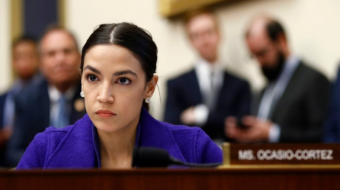
The daunting takeaway from Stanley Nelson’s Black Panther Party: Vanguard of Revolution is that almost every issue that gave rise to the Black Panther Party has yet to be resolved. Police brutality, economic inequality, social injustice and even lack of voting rights continue to plague African Americans. Yet the Panthers caught the imagination of many, ignited the ire of others and left a legacy that begs fulfillment.
Emmy Award winner and MacArthur Fellow, Nelson (Freedom Riders, Jonestown, The Murder of Emmet Till) has forged a stirring, thought provoking montage of film clips, talking heads and still photos of one of the most dramatic movements in modern American History. The adroit editing of Aljernon Tunsil and the exuberant score breathe more life than nostalgia into this moving history.
Through these deft series of film clips and testimony, Nelson chronicles the rise and fall of the Black Panthers. Unlike the Civil Rights Movement in the American South, Black activism on the West Coast did not express itself as a push for voting rights, educational inclusion or an attack on Jim Crow laws.
Blacks in West Coast cities first rebelled against repressive police abuses. Confronted by this brutality in everyday life, Huey P Newton and Bobby Seale founded the Black Panther Party for Self Defense. Seale and Newton, students at Oakland’s Merritt College drew on the study of Black History, as well as their own experience. All around them, Black accommodationists and service agencies failed. So in October 1966, they banded together for protection, survival and advancement.
Newton organized patrols to follow the police. Having studied laws regulating firearms, Seale and Newton legally armed their Black Patrols. To show discipline, they established a standard uniform of blue shirts, black pants, black leather jackets, black berets and sunglasses and borrowed Black Power advocate Stokely Carmichael’s Black Panther emblem.
These paramilitary patrols gained the Panthers a growing following. They made shock waves nationally when thirty armed and uniformed Panthers marched through the California State Capitol. Then Governor Ronald Reagan and others decried “nuts with guns,” quickly passing gun control laws!
But the Panthers were as much about community development, as protection. They established wildly popular food, health, housing and service programs, providing 20,000 meals a week, offering clinics and setting up free schooling supplementing traditional academics with courses on Black History, political ideology and survival.
As the Panthers’ popularity grew and the organization established branches in 68 cities, the Right Wing reacted. FBI Head J Edgar Hoover’s named the Panthers as the greatest internal threat in the United States. Film maker Nelson shows Hoover’s responses to reporters when asked if he thought the nation was in trouble. “I think very definitely it is,” said Hoover. “I think the answer is vigorous law enforcement.” But when asked about justice, Hoover sternly intones “Justice is merely incidental to law and order!”
The FBI set up COINTELPRO, a counter intelligence program, to neutralize the Panthers and any other “dangerous” groups, which according to them included the Southern Christian Leadership Conference, the Student Non-violent Coordinating Committee and the Reverend Martin Luther King, Jr. Through COINTELPRO and allied law enforcement agencies, the FBI engaged in a number of illegal activities including harassment, provocation, intimidation and violence, ultimately initiating and joining other agencies in raids, which resulted in the jailing of Panther leaders and the killing of Fred Hampton and Mark Clark. Legal or not, FBI actions helped destabilize the Panthers.
But Nelson also focuses an unflinching electronic eye on the Party’s internal weaknesses – the violence, drugs and corruption which damaged the organization. Problems with unequal treatment of women plagued the organization despite Panther ideology, proclamations and attempts to promote equality.
As attacks and self destructiveness weakened the organization, membership shrunk. The painful involvement of co-founder Huey P Newton with drugs and questionable violence ran counter to the group’s socialist and anti-imperialist ideology. Leadership faded despite the heroic efforts of Elaine Brown, who headed the Party from 1974 through 1977. The organization that once inspired fear and improved police behavior, fed children and taught working class solidarity, virtually ceased to exist.
Still its legacy persists, as the very forces which created the Panthers persist. Here Nelson’s stirring history, despite the unfulfilled promise of its subject, provides a lesson. The successes and failures of the Panthers show the ways social movements, even revolutions are made.
The Official Theatrical Trailer of The Black Panthers: Vanguard of the Revolution:
Photo: Facebook.












Comments